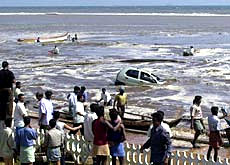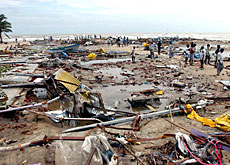Quake was detected in Switzerland

The devastation caused by the earthquake that hit southeast Asia would have been almost impossible to prevent, even with warning systems in place.
That’s according to the Swiss Seismological Service, which said the quake registered on Swiss instruments hours before killer tsunamis hit the region’s coastlines.
Manfred Baer of the Swiss Seismological Service in Zurich told swissinfo that, although earthquakes are impossible to predict, the likelihood of tsunami waves could be determined with a good degree of accuracy.
“Tsunamis travel more slowly than seismic waves so it is possible to determine whether an earthquake is likely to cause tsunamis,” said Baer.
In the case of the southeast Asia quake, Baer estimates that Sri Lanka would have had two hours’ notice that killer waves were heading for its shores, if a tsunami warning system had been in place.
“That would have given the authorities time to warn people in coastal areas,” he added. “In the Maldives it would have been more difficult to prevent a catastrophe because the islands lie at sea level, providing no higher ground for people to escape the water.”
Casualties
But Baer is sceptical that much could have been done to limit casualties, even with tsunami warning systems in place.
“Even with warnings, if the countries were not prepared in advance, it wouldn’t have helped.”
Baer said a warning system, such as that in Hawaii, was only effective if the inhabitants of coastal areas were prepared and trained to react quickly. “People have to be organised, to know what to do.”
He added that this would require training in emergency procedures in advance – a massive undertaking, requiring both sophisticated logistics as well as political will.
Predicting earthquakes
Baer said predicting earthquakes remained impossible and that it would be decades, if not hundreds of years, before science would be able to accurately determine whether a quake was imminent.
Sunday’s quake, which occurred off the west coast of the Indonesian island of Sumatra, was one of the largest in recorded history, reaching 9.0 on the Richter scale. The biggest ever measured struck Chile in 1960 with a magnitude of 9.5.
Baer said the impact would have been much worse had Sunday’s quake occurred on land. Because the epicentre was located under the seabed, most of the devastation was caused by tsunamis.
Tsunamis spread out in concentric circles, much like ripples caused by a stone dropping into water.
Tremor
A tremor on the seabed sends out waves, which in the open ocean are hardly noticeable. Baer said tsunamis in the open water are typically just one to two metres high and tend to be 100 to 200 kilometres apart.
“A ship in the open ocean would not notice them,” he told swissinfo.
However, tsunamis contain vast amounts of energy because they extend from the seabed to the surface. “In the open ocean, the sea floor can be 5,000 metres deep,” said Baer. As a tsunami approaches shallower water, this “energy becomes concentrated towards the surface”.
When the tsunami finally hits the shore, the force is equivalent to the mass of the water and the velocity of the wave.
The result is typically devastation like that witnessed across the coasts of southeast Asia. Eyewitnesses spoke of waves just one or two metres high but with enough force to sweep boats ashore, overturn buses and cars, and destroy structures.
The seismic effects of an earthquake on land can be felt up to 100 kilometres away, depending on its size. Tsunamis triggered by quakes under the ocean travel thousands of kilometres.
swissinfo
Tsunamis are triggered by activity on the sea floor.
They spread out in concentric circles, much like ripples caused by a stone falling into water.
They contain vast amounts of energy because they extend from the seabed to the surface.
They hit the shore with a force equivalent to the mass of the water and the velocity of the wave.
Earthquakes are impossible to predict, but forecasts can be made about tsunamis.
Sri Lanka would have had two hours’ notice that killer waves were heading for its shores, had a warning system had been in place.
Swiss experts say warning systems are only effective if the inhabitants of coastal areas are trained to react quickly.

In compliance with the JTI standards
More: SWI swissinfo.ch certified by the Journalism Trust Initiative










You can find an overview of ongoing debates with our journalists here . Please join us!
If you want to start a conversation about a topic raised in this article or want to report factual errors, email us at english@swissinfo.ch.